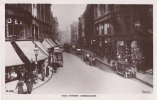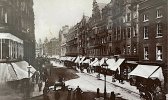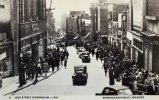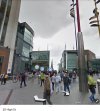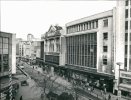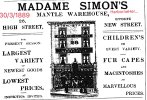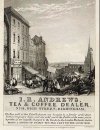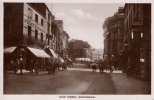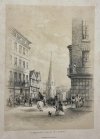-
Welcome to this forum . We are a worldwide group with a common interest in Birmingham and its history. While here, please follow a few simple rules. We ask that you respect other members, thank those who have helped you and please keep your contributions on-topic with the thread.
We do hope you enjoy your visit. BHF Admin Team
You are using an out of date browser. It may not display this or other websites correctly.
You should upgrade or use an alternative browser.
You should upgrade or use an alternative browser.
High Street Birmingham
- Thread starter Vivienne14
- Start date
Lady Penelope
master brummie
Hi Viv, Smashing picture! I think that your post #91 is probably fairly accurate! I was tracing a family of cabbies from around that time and it was indeed chaos with private vehicles, pedestrians, horsemen, as well as the omnibuses, deliveries etc. and I don't suppose the roads were free from debris either. Lots of accidents caused by cabbies wanting to get as many passengers as possible and there weren't any drink-driving laws then. Cabbies (and possible 'bus drivers) often whet their whistles.
53 High Street was the location of the waiting room and parcel office for The Birmingham Omnibus Company (known as 'The Company'), a business that transformed horse drawn bus services in Birmingham.A humorous look at the chaos outside the Omnibus Office at 55 High Street in 1869. Possibly not entirely accurate but interesting that this was someone’s view of High Street when passengers were boarding/disembarking coaches. Think I’d rather walk !
View attachment 169686
Source: Birmingham Transport by Alec Jenson
In 1869, the borough of Birmingham and its immediate suburbs had a population of 400,000, which was served by just around 20 buses running on 15 local routes, all run by small independent operators.
All this changed in June 1869 when two brothers - William and Daniel Busby - arrived from Liverpool and proposed to introduce the 'Liverpool system' of more frequent journeys and low fares.
'The Company' immediately introduced an initial batch of 10 new buses, built by Miller's of London. These buses were put on routes to Moseley, Bristol Road, Hagley Road, Handsworth and Aston Park. Later destinations were Kings Heath, Selly Oak, Hockley, Nechells and Coventry Road. The fares charged were 2d for an outside seat and 3d for an inside seat for the whole length of each route. To provide this service The Company acquired premises in Alcestor Street for the stabling of nearly 200 horses.
The proprietors of the old independent bus operators responded with lower fares, more buses and more journeys. Competition was fierce.
'The Company' had a short life as an independent business. On the 12 October 1871, having transformed the Birmingham bus business sector, 'The Company' was sold to the Birmingham and District Tramways Co. Ltd.
(Source: 'Birmingham Transport: A History of Public Road Transport in the Birmingham Area by Alec G Jenson, 1978').
(Image from "'Sketches in the Midlands', by 'Daylight and Gaslight', No.1. Birmingham Buses. The Illustrated Midland News,18 December 1869.")
Last edited:
NoddKD
master brummie
Fantastic upper floor frontages. Whenever I visit places such as Exeter or Canterbury I always look up at the architecture of the older buildings and I am always impressed. I wonder what will impress future generations in Birmingham?
NoddKD
Janet Hunt
master brummie
I doubt much will impress them, apart from faster internet, many rarely look up from their phones let alone look up at buildings...sad really. Personally I have always been a "looker upper-er" My Nan always used to say Look up and straight ahead you never know what excitements you will miss if you look down"Fantastic upper floor frontages. Whenever I visit places such as Exeter or Canterbury I always look up at the architecture of the older buildings and I am always impressed. I wonder what will impress future generations in Birmingham?
NoddKD
Jan
I’m from a non-looker upper generation. Rarely looked above which if I had done in the 1960s/70s/80s would have at least appreciated the finer points of many buildings that have since disappeared.
I’m now a firm looker-upper and never miss an opportunity to scan the upper levels of most buildings.
NoddKD - I live not far from Canterbury and I have to say you never cease discovering new features of buildings. Not only are many so old, they’re also full of detail and generally well preserved. The other aspect about Canterbury is new-builds are mostly (not always) developed in a complementary style. They’re usually low level and often feature traditional building methods. Sometimes it’s difficult to distinguish a modern terrace of houses from a Georgian Row. Other cities could learn a lot from the place.
Viv.
I’m now a firm looker-upper and never miss an opportunity to scan the upper levels of most buildings.
NoddKD - I live not far from Canterbury and I have to say you never cease discovering new features of buildings. Not only are many so old, they’re also full of detail and generally well preserved. The other aspect about Canterbury is new-builds are mostly (not always) developed in a complementary style. They’re usually low level and often feature traditional building methods. Sometimes it’s difficult to distinguish a modern terrace of houses from a Georgian Row. Other cities could learn a lot from the place.
Viv.
A few of points about High Street from this piece. Marsh’s was soon to disappear to make way for the Arcade on High Street, a change to numbering was applied after the Arcade was built and the remaining buildings were redeveloped following bomb damage on New Street. Viv.
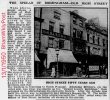
Source: British Newspaper Archive

Source: British Newspaper Archive
mw0njm.
A Brummie Dude
sadly yes.These two photos are listed as demolition of the Co-op Birmingham in the 1980s. Is/was it the High Street Co-op ? Viv
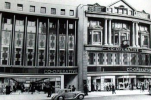 i never knew there was a tunnel. till now
i never knew there was a tunnel. till nowCo-op and "The Tunnel"
I have clear memories of shopping in the Co-op store on High Street (now the site of the Pavillions). I cant remember how many floors it had or whether it sold food as a modern Co-op would. What has really surprised me is reading about: the tunnel. Apparently before my experiences, Co-op also...
 birminghamhistory.co.uk
birminghamhistory.co.uk
Dennis Williams
Gone but not forgotten
sadly yes.
View attachment 173423i never knew there was a tunnel. till now
Co-op and "The Tunnel"
I have clear memories of shopping in the Co-op store on High Street (now the site of the Pavillions). I cant remember how many floors it had or whether it sold food as a modern Co-op would. What has really surprised me is reading about: the tunnel. Apparently before my experiences, Co-op also...birminghamhistory.co.uk
Is it me or isn't this "tunnel" the old entrance to Scotland Passage....? Or have I missed summat..?

mw0njm.
A Brummie Dude
thanks.viv......please keep pics coming
Attachments
And some of the High Street buildings to the right of the photo in post #104 as drawn in 1849. Is the sign “Hall” above Aris’s Gazette a business name or a building name ?
For reference see posts and map in #20 and #21 of this thread for the extent of High Street at this point (ending at Bell Street to the right and Moor Street to the left) Viv
For reference see posts and map in #20 and #21 of this thread for the extent of High Street at this point (ending at Bell Street to the right and Moor Street to the left) Viv

Last edited:
High Town was originally the name of the north end of the High Street before its descent to the Bull Ring. (It also became a term used to describe a new district as the town developed in the 18th century. Bradley's map of 1750 shows High Town as a district located between Colmore Row and the High Street).
Westley’s 1730 map shows High Town (the street) before the wider town development referred to above and the later use of the term to describe a district. In 1730 did ‘High Town’ extend as far as Bell Street/Spicer Street junction, as the later ‘High Street’ did ?
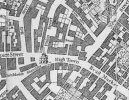
Westley’s 1730 map shows High Town (the street) before the wider town development referred to above and the later use of the term to describe a district. In 1730 did ‘High Town’ extend as far as Bell Street/Spicer Street junction, as the later ‘High Street’ did ?

Yes. No.26 is on the east side of High Street facing the junction with New Street.I’m guessing this must have been around the point where High Street drops down towards the Bull Ring/Digbeth. Very fashionable to adopt a French name for any clothing supplier.
Viv
View attachment 176574Source: British Newspaper Archive
Covroad
master brummie
Found this advertisement relating to a Tea and Coffee business I R Andrews 11High Street the advert makes reference to the East India Tea company .High Town was originally the name of the north end of the High Street before its descent to the Bull Ring. (It also became a term used to describe a new district as the town developed in the 18th century. Bradley's map of 1750 shows High Town as a district located between Colmore Row and the High Street).
Westley’s 1730 map shows High Town (the street) before the wider town development referred to above and the later use of the term to describe a district. In 1730 did ‘High Town’ extend as far as Bell Street/Spicer Street junction, as the later ‘High Street’ did ?
View attachment 173884
Source
Attachments
This photo shows #83, #84 and the edge of the Grand Louvre building. Innes Smith & Co were wine merchants. Looks like there might have been a bar on the premises too.
I think these buildings must have been damaged during WW2 bombing. If so they would have been demolished and site subsequently became part of the Big Top. Viv.
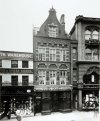
I think these buildings must have been damaged during WW2 bombing. If so they would have been demolished and site subsequently became part of the Big Top. Viv.

Last edited:
Lady Penelope
master brummie
Really unusual picture Viv, I like the balconies!
Agree LadyP. I'm also intrigued by the display of the military making their way through the Bull Ring. A reaction to the Riots in the previous year ? And/or a precautionary show of strength as the newly established local police service gets into full swing ? Or just simply parading to show Birmingham inhabitants it's readiness to protect this country ? Whatever the reason, it must have been included in the drawing to show strength and instill confidence judging by the rearing horse carrying the officer at the rear. Viv.
Last edited:
Lady Penelope
master brummie
Viv, I was too taken up with the balconies to notice the horse although, a you say, it was centre stage! I wonder what regiment the men were from? There was a lot of recruitment in Birmingham for the marines around this time. I'm sure someone can tell us.
Thanks for sharing those, Viv. If I have my bearings right, both show a good view of No. 1 Dale End (the tobacconist with the fan of awnings). That location (and perhaps building) was, in the 1820s/30s, the wireworking workshop and show rooms of my relative Joseph Allday (journalist, town councillor, alderman, church warden and prison reformer), of whom I've written elsewhere.Two great views of High Street, the second taken at the Bull Street/Dale End junction. Viv.View attachment 179415View attachment 179416




